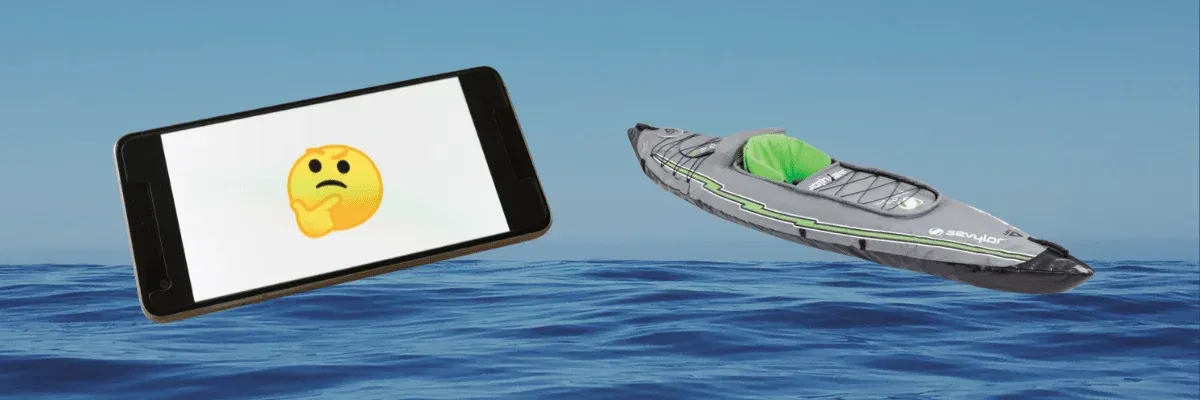Key Takeaways:
- Inflatable kayaks have evolved with safety features like multiple air chambers and thick coated materials, making them comparable to hardshell kayaks.
- Proper maintenance, understanding of kayak stability, and adherence to safety precautions are crucial for a safe inflatable kayak experience.
- Inflatable kayaks are suitable for various water conditions, from calm water to rough water, provided they are used within their design limits.

Inflatable kayaks have surged in popularity among outdoor enthusiasts and water sport aficionados. Their portability, easy storage, and versatility make them an attractive option for many. But a question lingers in the minds of prospective buyers and seasoned paddlers alike: "Are inflatable kayaks safe?" This article will delve into the safety aspects of inflatable kayaks, comparing them to traditional kayaks, and provide insights into how to ensure a secure kayak adventure.

Understanding Inflatable Kayak Safety
The safety of inflatable kayaks is often underestimated. Modern inflatable kayaks are designed with advanced features that enhance their stability and durability. Many inflatable kayaks come equipped with multiple air chambers, which not only make them incredibly buoyant but also ensure that the kayak stays afloat even if one chamber is compromised. The use of thick coated materials and tough construction like drop stitch technology contributes to their ability to withstand tough conditions.
Comparing Inflatable and Hardshell Kayaks
When it comes to comparing inflatable kayaks with hardshell kayaks, it's important to consider the advancements in inflatable kayak technology. Most inflatable kayaks now have a level of primary and secondary stability that rivals that of a regular hardshell kayak. The elevated seat in many inflatable kayaks provides a stable platform, reducing the risk of rolling sideways. Additionally, the carrying capacity of inflatable kayaks often matches or exceeds that of hardshell kayaks.
The Role of Quality in Inflatable Kayak Safety
Not all inflatable kayaks are created equal. A high-quality inflatable kayak is less likely to puncture easily and can withstand harsh conditions. Quality inflatable kayaks are made from durable materials and feature multiple layers of protection against sharp objects. When considering an inflatable kayak, it's essential to look for features that indicate a commitment to safety, such as a robust build and a reliable repair kit.
Stability: A Key Factor in Kayak Safety
Stability is a critical factor in the safety of any kayak. Inflatable kayaks tend to have a wide base, which provides a stable platform for activities like kayak fishing or paddle boarding. The design of most inflatable kayaks includes considerations for both primary and secondary stability, ensuring that they perform well in various water conditions, from flatwater lakes to open ocean expeditions.
Inflatable Kayaks in Extreme Conditions
While many inflatable kayaks are suitable for calm water and light recreational use, some models are specifically designed for extreme conditions, such as whitewater kayaking. These kayaks are built with extra-tough materials and construction methods that enable them to withstand the challenges of rough water and sharp rocks, ensuring maximum performance and safety.
Safety Precautions for Inflatable Kayak Users
Regardless of the type of kayak, safety precautions are paramount. Wearing a life jacket, checking weather conditions, and carrying a small patch kit are essential practices for anyone embarking on a kayak adventure. Additionally, ensuring that the inflatable kayak is not under-inflated and that all air chambers are properly sealed can prevent accidents and improve the overall safety of the inflatable watercraft.
Inflatable Kayak Durability: Myths and Materials
Inflatable kayaks often get a bad rap for being less durable than their hardshell counterparts, but is this reputation deserved? Modern inflatable kayaks are crafted from thick coated materials and multiple layers that can withstand tough conditions, much like a high-quality inflatable boat. Many inflatable kayaks feature robust construction with drop stitch construction that can resist punctures from sharp objects, ensuring they don't easily succumb to the wear and tear of regular use. The notion that inflatable kayaks puncture easily is becoming a myth as advanced materials and manufacturing techniques continue to evolve.
The durability of an inflatable kayak is not just about the materials, though. It's also about the design. Many modern inflatable kayaks come equipped with multiple air chambers, which means that even if one chamber is compromised, the kayak will stay afloat. This redundancy is a critical aspect of inflatable kayak safety. Additionally, the use of tough materials like PVC and Nitrylon in the construction of inflatable kayaks means they can withstand harsh conditions, from sharp rocks in rivers to the abrasive sands of coastal beaches, making them a reliable choice for water sports enthusiasts.

The Convenience Factor: Inflatable Kayaks on the Go
One of the most appealing aspects of inflatable kayaks is their convenience. Unlike a regular hardshell kayak, an inflatable kayak can be deflated, rolled up, and packed into a carry bag, making it ideal for those with limited storage space or those who wish to travel with their kayak. This easy storage and transportability mean that your kayak adventure expeditions are no longer limited by the size of your vehicle or the proximity to water. Inflatable kayaks are also incredibly buoyant, making them a stable platform for activities like kayak fishing or paddle boarding, where mobility and stability are key.
Moreover, the setup time for most inflatable kayaks is minimal, with many models inflating in minutes using a hand pump or even an electric pump. This quick transition from land to water allows for more time enjoying the water sport and less time in preparation. The elevated seat found in many inflatable kayaks not only provides comfort for longer paddling sessions but also offers a better vantage point for fishing kayaks. Whether you're exploring flatwater lakes or engaging in whitewater kayaking, the convenience of an inflatable kayak is undeniable, providing maximum performance without the hassle of transportation and storage that comes with traditional kayaks.
Maintenance and Care for Inflatable Kayaks
Proper maintenance is crucial for keeping an inflatable kayak safe. Regular inspections for leaks or wear, cleaning after use, and proper storage away from sharp objects and extreme temperatures can extend the life of an inflatable kayak and prevent safety issues. A well-maintained inflatable kayak is less likely to encounter problems that could compromise its safety on the water.
The Evolution of Inflatable Kayak Design
Inflatable kayak design has come a long way from the simple kayak pool toy image many still hold. Modern inflatable kayaks feature advanced elements like drop stitch construction and reinforced seams, which contribute to their safety and performance. These design improvements have made inflatable kayaks a viable option for serious water sports enthusiasts.
Accessories That Enhance Inflatable Kayak Safety
Accessories can play a significant role in enhancing the safety of an inflatable kayak. Items like a bilge pump, kayak cart, and additional flotation devices can be invaluable in emergency situations. Moreover, a well-designed kayak seat can improve comfort and control, reducing the risk of accidents.
Inflatable Kayaks and Fishing: A Safe Combination?
Kayak fishing has gained popularity, and many inflatable kayaks are designed to provide a safe and stable platform for anglers. Fishing kayaks often have additional features like rod holders and gear storage, which not only add convenience but also contribute to the kayak's stability and safety.
Inflatable Boats vs. Inflatable Kayaks
It's important to distinguish between inflatable boats and inflatable kayaks. While both are inflatable watercraft, kayaks are generally designed for more active use and have features that make them safe for paddling in various conditions. Inflatable boats may not have the same level of stability or performance as kayaks designed for paddling.
The Future of Inflatable Kayak Safety
The future of inflatable kayak safety looks promising, with manufacturers continually innovating to create even safer and more reliable products. As materials and construction techniques improve, inflatable kayaks will likely become even more comparable to their hardshell counterparts in terms of safety and performance.
Choosing the Right Inflatable Kayak for Safety
When selecting an inflatable kayak, it's important to consider the intended use and the kayak's safety features. A kayak designed for flat water may not be safe for open ocean use, and vice versa. Researching and understanding the specifications and limitations of different models can help ensure a safe and enjoyable experience.

Summary
Inflatable kayaks have come a long way in terms of safety and reliability. With features like multiple air chambers, thick coated materials, and advanced construction techniques, modern inflatable kayaks offer a level of safety that can rival traditional hardshell kayaks. However, it's crucial for paddlers to choose the right kayak for their intended use, maintain it properly, and always follow safety precautions. By doing so, inflatable kayaks can provide a safe and enjoyable experience for all types of water adventures.

FAQs
Can inflatable kayaks puncture easily?
High-quality inflatable kayaks are designed with durable materials and multiple layers of protection, making them resistant to punctures. However, like any inflatable product, they can be punctured if they come into contact with sharp objects. Proper care and avoiding hazardous areas can minimize this risk.
Are inflatable kayaks suitable for whitewater kayaking?
Yes, there are inflatable kayaks specifically designed for whitewater kayaking. These kayaks are built with tough materials and construction methods that enable them to withstand the rigors of rough water. It's important to choose a kayak that is rated for the level of whitewater you plan to navigate.
How do I ensure my inflatable kayak is safe to use?
A: for any signs of wear or damage, make sure it is properly inflated, and that all air chambers are sealed. Additionally, carry a repair kit, wear a life jacket, and follow all recommended safety precautions for the water conditions you'll be facing.









